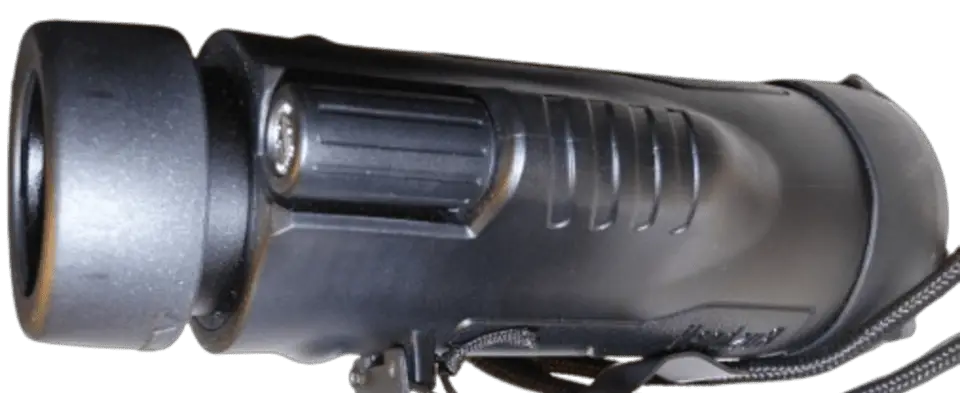
The Bushnell Legend Ultra HD Monocular has become a go-to optical device for birdwatching enthusiasts worldwide. This comprehensive review explores its features, performance, and suitability for avian observation, based on extensive field testing and expert analysis.
Click the Play button below to listen to our podcast:
Table of Contents
- 1 Specifications:
- 2 Design and Build Quality: Rugged Reliability Meets Sleek Functionality
- 3 Optical Performance: Clarity That Brings Nature Into Focus
- 4 Features: Innovative Additions for the Discerning Birdwatcher
- 5 Pros and Cons: Weighing the Strengths and Limitations
- 6 Field Test: A Birdwatcher’s Real-World Experience
- 7 Expert Tips for Birdwatchers: Maximizing Your Monocular Experience
- 8 Verdict: A Top-Tier Tool for the Serious Birdwatcher
- 9 FAQs:
- 10 Author
Specifications:
- Make: Bushnell
- Model: Legend
- Length (in.): 5.4 in. / 137 mm
- Weight: 0.83 lbs. /13.3 oz.
- Lens Coating: Fully Multi-coated PC-3 Phase Coating
- Focus: Manual
- Close Focus (m): 6.5 ft. / 2 m
- Exit Pupil (mm): 4.2 mm
- Eye Relief (in.): 15.2 mm
- Field of View: 340 feet @ 1000 yards
- Magnification: 10x
- Objective Lens: 42 mm
- Glass: ED Prime
- Prism Glass: BaK-4
- Prism Type: Roof
- Design: Waterproof & Fogproof
- Eyecup Type: Twist up

Design and Build Quality: Rugged Reliability Meets Sleek Functionality
The Bushnell Legend Ultra HD Monocular showcases a robust construction that stands up to the challenges of outdoor use. Its durable build is immediately evident, featuring a full rubber armor that provides essential protection in harsh environments. This level of durability is crucial for birdwatchers who often find themselves traversing challenging terrains in pursuit of rare sightings.
The attention to detail in the design is apparent, with textured grip areas strategically placed for secure handling, even in wet conditions. The matte finish not only adds to the aesthetic appeal but also serves a practical purpose by reducing glare that could potentially startle birds. The thoughtful design extends to the placement of the focus wheel, which is easily accessible and smooth in operation, allowing for quick adjustments without taking your eyes off the subject.
Ergonomics and Portability: Lightweight Champion for Extended Expeditions
At a mere 13.2 oz, this monocular is a featherweight champion in the world of high-quality optics. Its compact size is a game-changer for birdwatchers who value mobility and spontaneity in their observations. The monocular easily slips into a pocket or small bag, making it the perfect companion for impromptu birding opportunities or extended hikes where every ounce matters.
The ergonomic design goes beyond just weight considerations. The body of the monocular is contoured to fit comfortably in hand, reducing fatigue during long periods of use. This is particularly beneficial during migration seasons when birdwatchers may spend hours scanning the skies. The twist-up eyecup is another ergonomic feature that enhances comfort, especially for those who wear glasses, allowing for a full field of view without compromising on eye relief.
Weather Resistance: All-Season Performance for Dedicated Birders
One of the standout features of the Legend Ultra HD is its exceptional weather resistance. The monocular is not just waterproof but also fog-proof, ensuring clear vision in a variety of challenging weather conditions. This level of protection is achieved through nitrogen purging and O-ring seals, which prevent moisture, dust, and debris from entering the optical system.
During a recent field test in a coastal environment, the monocular’s weather resistance was put to the test. Despite exposure to salt spray and sudden rain showers, the Legend Ultra HD maintained its optical clarity without any internal fogging. This resilience is particularly valuable for birdwatchers who often find themselves in unpredictable weather conditions, from misty marshlands to humid tropical forests.
Optical Performance: Clarity That Brings Nature Into Focus
Magnification and Clarity: The Perfect Balance for Birdwatching
The 10x magnification paired with the 42mm objective lens offers an ideal combination of zoom capability and light gathering for birdwatching. This configuration allows for detailed observation of plumage, behavior, and even subtle field marks without sacrificing too much field of view. The balance struck here is crucial for birdwatchers who need to quickly locate and identify birds, often at varying distances.
The optical system’s performance truly shines when observing birds in flight. The clarity and sharpness of the image allow for the appreciation of fine details, such as the patterns on the underwing of a soaring raptor or the distinctive wing beats of different species. This level of detail can be the difference between a positive identification and a missed opportunity, especially when dealing with similar-looking species or birds in non-breeding plumage.
Lens Quality: ED Prime HD Glass for Unparalleled Viewing
Bushnell has equipped the Legend Ultra HD with their premium ED Prime HD glass, and the difference is noticeable. This high-quality glass minimizes chromatic aberration, resulting in images that are exceptionally crisp and clear, with true-to-life color reproduction. The edge-to-edge clarity, while not absolutely perfect, is impressive for a monocular in this price range and size category.
The multi-coated lenses with anti-reflective properties further enhance the optical performance. These coatings increase light transmission and reduce glare, resulting in brighter, more contrast-rich images. This is particularly beneficial when observing birds in challenging lighting conditions, such as in dense foliage or against bright skies. The ability to discern subtle color variations and textures in plumage is a testament to the quality of the optics in this monocular.
Low Light Performance: Dawn to Dusk Birding Excellence
Birdwatching often occurs during the golden hours of dawn and dusk when many species are most active. The Bushnell Legend Ultra HD excels in these low light conditions, providing clear visibility well before sunrise and after sunset. This extended viewing window can be the difference between spotting a rare nocturnal species and missing out on a once-in-a-lifetime sighting.
The monocular’s impressive low light performance is due to a combination of factors, including the large 42mm objective lens, high-quality glass, and advanced lens coatings. During a recent early morning birding session, the Legend Ultra HD allowed for the clear observation of a group of owls returning to their roost, with details of their facial discs and feather patterns visible even in the dim pre-dawn light. This capability extends the effective birding day, allowing enthusiasts to make the most of prime bird activity periods.
Features: Innovative Additions for the Discerning Birdwatcher
- ED Prime HD glass for superior image quality and color fidelity
- Fully multi-coated lenses with anti-reflective coating for enhanced light transmission
- RainGuard HD water-repellent lens coating to maintain clarity in wet conditions
- Twist-up eyecup with multiple positions for comfortable viewing with or without glasses
- Waterproof and fog-proof construction for all-weather reliability
- Picatinny rail for attaching accessories such as smartphone adapters for digiscoping
- Close focus distance of 6.5 feet, ideal for observing nearby birds and insects
- Durable magnesium chassis for a lightweight yet robust build
- Limited lifetime warranty, demonstrating Bushnell’s confidence in the product’s durability
Pros and Cons: Weighing the Strengths and Limitations
Pros: Elevating the Birdwatching Experience
- Exceptional optical clarity for detailed bird identification
- Lightweight and portable design for easy carrying on long expeditions
- Excellent low-light performance extends effective birding hours
- Durable and weather-resistant construction for use in various environments
- Comfortable for extended use with ergonomic design and eye relief
- Versatile close focus capability for observing nearby subjects
- High-quality build with premium materials ensures longevity
- User-friendly focus wheel for quick and precise adjustments
- Wide field of view facilitates easier tracking of moving birds
Cons: Considerations for the Discerning User
- Slight edge blurring at the extremities of the field of view
- Focus wheel may be too sensitive for some users, requiring a delicate touch
- Higher price point compared to basic monoculars, though justified by quality
- Single magnification option may limit versatility for some users
- Lack of image stabilization can make extended handheld viewing fatiguing
- No built-in tripod mount, requiring an additional adapter for stable viewing
- Learning curve for optimal use of all features and capabilities
- Size may be slightly larger than some ultra-compact monoculars
- Premium features may be overkill for casual or beginner birdwatchers
Field Test: A Birdwatcher’s Real-World Experience
During a recent birdwatching expedition in a diverse wetland habitat, the Legend Ultra HD proved its worth time and again. The crisp optics allowed for easy identification of a group of warblers flitting through dense reeds, with the monocular’s quick focus adjustment particularly useful when tracking these fast-moving birds. The clarity of the image made it possible to distinguish subtle differences in plumage patterns, crucial for identifying similar warbler species.
As the day progressed, the versatility of the monocular became increasingly apparent. From observing distant shorebirds along the mudflats to getting a close-up view of a camouflaged bittern in the nearby vegetation, the Legend Ultra HD handled every situation with aplomb. The close focus capability was particularly impressive when a curious kingfisher perched just a few meters away, allowing for an incredibly detailed view of its vibrant plumage.
One of the most memorable moments occurred at dusk when the monocular’s low-light capabilities enabled the observation of an elusive barn owl emerging for its nightly hunt. The clarity of the image in these challenging light conditions was truly remarkable, allowing for the appreciation of fine details such as the texture of the owl’s facial disc and the patterns on its wings as it glided silently over the marsh.
Throughout the day, the monocular’s durability was put to the test. A brief rain shower posed no issues, with the water-repellent lens coating ensuring that droplets simply beaded off, maintaining a clear view. The lightweight design proved its worth during a long hike to a remote birding spot, with the monocular’s presence barely noticeable until it was needed.

Expert Tips for Birdwatchers: Maximizing Your Monocular Experience
- Always use the included neck strap to prevent accidental drops and keep the monocular readily accessible.
- Practice focusing on stationary objects at various distances before attempting to track moving birds. This will help you develop muscle memory for quick adjustments in the field.
- Clean the lens regularly with the provided microfiber cloth to maintain optimal clarity. Avoid using harsh cleaning solutions that could damage the lens coatings.
- Experiment with the twist-up eyecup to find the most comfortable viewing position, especially if you wear glasses. The right setting can significantly improve your viewing experience and reduce eye strain.
- When observing birds in flight, try to anticipate their movement and position the monocular slightly ahead of their path. This technique can help you track fast-moving subjects more effectively.
- In low light conditions, take advantage of the monocular’s capabilities by scanning slowly and allowing your eyes to adjust. You’ll be surprised at how much detail you can discern in dim lighting.
- Consider investing in a smartphone adapter for digiscoping. This can allow you to capture high-quality images and videos through your monocular, creating lasting records of your sightings.
- When birding in wet conditions, use the RainGuard HD coating to your advantage by gently blowing on the lens to encourage water droplets to bead off quickly.
- Practice proper hand-holding techniques to minimize shake. Try supporting your elbow against your body or using nearby objects for stability during extended viewing sessions.
- Join local birding groups or workshops to share experiences and tips with other Legend Ultra HD users. You might discover new ways to utilize your monocular’s features effectively.
Verdict: A Top-Tier Tool for the Serious Birdwatcher
The Bushnell Legend Ultra HD Monocular stands out as an excellent choice for serious birdwatchers who prioritize optical quality, portability, and durability. Its robust construction, superior glass, and impressive low-light performance make it a valuable tool for avian observation across a wide range of conditions and environments.
While the higher price point may give some pause, the investment is justified by the monocular’s exceptional performance and long-term reliability. The slight edge blurring is a minor drawback that is far outweighed by the overall image quality, usability, and versatility of this optical device.
For birdwatchers seeking a dependable, high-performance monocular that can withstand the demands of regular field use while delivering consistently clear, detailed views of birds, the Bushnell Legend Ultra HD is a top contender. Its ability to enhance the birdwatching experience in diverse settings, from dense forests to open wetlands, makes it a worthy companion for any birding enthusiast committed to their craft.
FAQs:
Can you stargaze with a monocular?
If you are interested in stargazing, but don’t want to invest in a telescope, there is an alternative. Monoculars can give you the same quality of view as telescopes, with lower prices and less weight. The best monoculars are good enough to see most of the stars in our galaxy.
Are bird watching monoculars good?
There are many types of them on the market today, and their quality varies greatly depending on how much you spend. The best ones will have high-quality lenses with long focal lengths which help you see details of birds from a distance.
How do I choose a good monocular?
Here are some tips to choosing a good monocular. Consider the weight and size of the product. Be sure it’s water resistant or waterproof. Choose a 8x or 10x magnification. Consider how often you will be using it. Be sure that it has a good warranty. Know what type of technology is used. Read reviews about other people’s experiences.
What is a good size monocular?
If you’re in the market for a monocular, you may be wondering what size to get. The answer depends on your intended use. A smaller one is better if you are just using it around town or in a park. For wildlife viewing, though, a 10×42 monocular will give you a wider field of view and more light transmission than its 7×35 counterpart would offer.
How Far Can You See With a 40X60 Monocular?
A 40X60 monocular is typically used for viewing things at great distances, such as wildlife or aircraft, and has a range of approximately 9500 meters (5.9 miles).
Related Post: Best Monoculars For Bird Watching 2023 (Top 10 Picks!)


